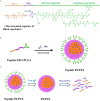Extracellular Matrix: Emerging Roles and Potential Therapeutic Targets for Breast Cancer
- PMID: 33968752
- PMCID: PMC8100244
- DOI: 10.3389/fonc.2021.650453
Extracellular Matrix: Emerging Roles and Potential Therapeutic Targets for Breast Cancer
Abstract
Increasing evidence shows that the extracellular matrix (ECM) is an important regulator of breast cancer (BC). The ECM comprises of highly variable and dynamic components. Compared with normal breast tissue under homeostasis, the ECM undergoes many changes in composition and organization during BC progression. Induced ECM proteins, including fibrinogen, fibronectin, hyaluronic acid, and matricellular proteins, have been identified as important components of BC metastatic cells in recent years. These proteins play major roles in BC progression, invasion, and metastasis. Importantly, several specific ECM molecules, receptors, and remodeling enzymes are involved in promoting resistance to therapeutic intervention. Additional analysis of these ECM proteins and their downstream signaling pathways may reveal promising therapeutic targets against BC. These potential drug targets may be combined with new nanoparticle technologies. This review summarizes recent advances in functional nanoparticles that target the ECM to treat BC. Accurate nanomaterials may offer a new approach to BC treatment.
Keywords: breast cancer; extracellular matrix; nanoparticles; remodeling enzymes; therapeutic targets.
Copyright © 2021 Zhao, Zheng, Zheng, Chen, Fei, Wang and Zheng.
Conflict of interest statement
The authors declare that the research was conducted in the absence of any commercial or financial relationships that could be construed as a potential conflict of interest.
Figures


Similar articles
-
The extracellular matrix in breast cancer.Adv Drug Deliv Rev. 2016 Feb 1;97:41-55. doi: 10.1016/j.addr.2015.12.017. Epub 2015 Dec 30. Adv Drug Deliv Rev. 2016. PMID: 26743193 Review.
-
Extracellular matrix components in breast cancer progression and metastasis.Breast. 2013 Aug;22 Suppl 2:S66-72. doi: 10.1016/j.breast.2013.07.012. Breast. 2013. PMID: 24074795 Review.
-
The biomimetic extracellular matrix: a therapeutic tool for breast cancer research.Transl Res. 2022 Sep;247:117-136. doi: 10.1016/j.trsl.2021.11.008. Epub 2021 Nov 27. Transl Res. 2022. PMID: 34844003 Review.
-
Mechanisms of breast cancer metastasis: the role of extracellular matrix.Mol Cell Biochem. 2025 May;480(5):2771-2796. doi: 10.1007/s11010-024-05175-x. Epub 2024 Dec 9. Mol Cell Biochem. 2025. PMID: 39652293 Review.
-
The Extracellular Matrix: Its Composition, Function, Remodeling, and Role in Tumorigenesis.Biomimetics (Basel). 2023 Apr 5;8(2):146. doi: 10.3390/biomimetics8020146. Biomimetics (Basel). 2023. PMID: 37092398 Free PMC article. Review.
Cited by
-
FGFR2 Controls Growth, Adhesion and Migration of Nontumorigenic Human Mammary Epithelial Cells by Regulation of Integrin β1 Degradation.J Mammary Gland Biol Neoplasia. 2023 May 16;28(1):9. doi: 10.1007/s10911-023-09537-x. J Mammary Gland Biol Neoplasia. 2023. PMID: 37191822 Free PMC article.
-
Simulations of tumor growth and response to immunotherapy by coupling a spatial agent-based model with a whole-patient quantitative systems pharmacology model.PLoS Comput Biol. 2022 Jul 22;18(7):e1010254. doi: 10.1371/journal.pcbi.1010254. eCollection 2022 Jul. PLoS Comput Biol. 2022. PMID: 35867773 Free PMC article.
-
Integrated Transcriptomic Analysis Revealed Hub Genes and Pathways Involved in Sorafenib Resistance in Hepatocellular Carcinoma.Pathol Oncol Res. 2021 Oct 19;27:1609985. doi: 10.3389/pore.2021.1609985. eCollection 2021. Pathol Oncol Res. 2021. PMID: 34737677 Free PMC article.
-
A novel preclinical model of the normal human breast.J Mammary Gland Biol Neoplasia. 2024 May 2;29(1):9. doi: 10.1007/s10911-024-09562-4. J Mammary Gland Biol Neoplasia. 2024. PMID: 38695983 Free PMC article.
-
Spatial Transcriptomic Analysis Reveals Associations between Genes and Cellular Topology in Breast and Prostate Cancers.Cancers (Basel). 2022 Oct 4;14(19):4856. doi: 10.3390/cancers14194856. Cancers (Basel). 2022. PMID: 36230778 Free PMC article.
References
-
- Tian Q, Wang Y, Guo H, Xie G, Li J, Zhang M, et al. . Recent perspectives of management of breast cancer metastasis - an update. J BUON (2017) 22(2):295–300. - PubMed
Publication types
LinkOut - more resources
Full Text Sources
Other Literature Sources

